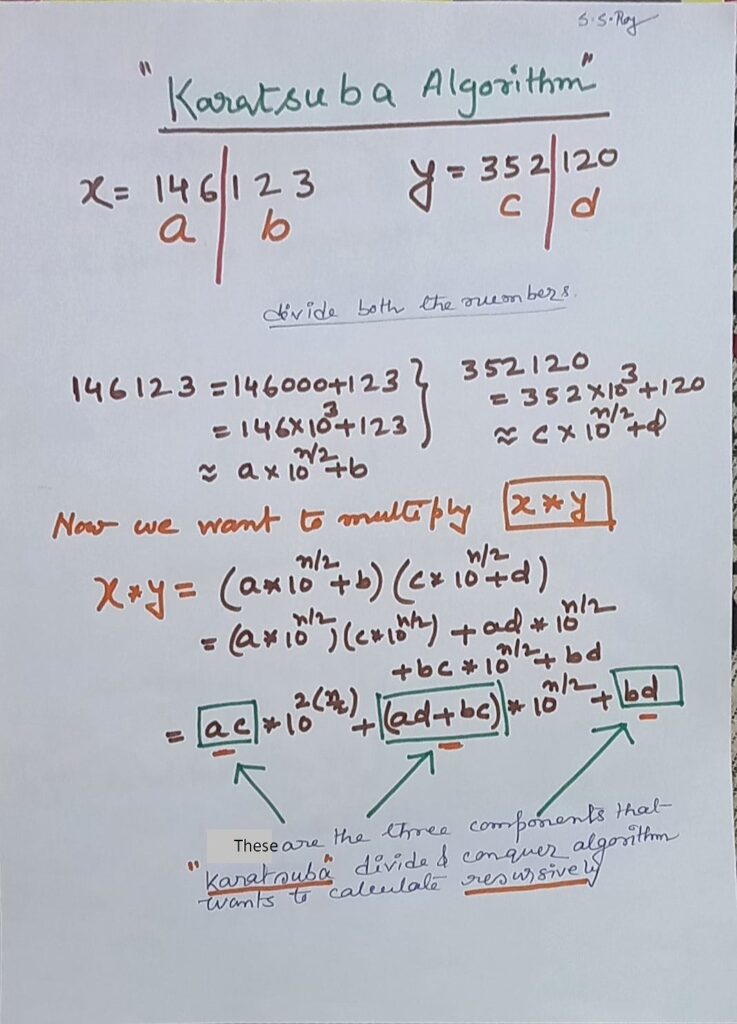In the realm of efficient multiplication algorithms, Karatsuba stands as a true algorithm, illuminating the path to faster and more elegant computations. Named after Anatolii Alexeevitch Karatsuba, the Russian mathematician who introduced it in 1960, this algorithm transcends traditional multiplication methods, offering a remarkable blend of simplicity and efficiency.
Understanding the Essence:
At its core, Karatsuba algorithm embodies the spirit of divide and conquer. Unlike traditional multiplication, which relies on elementary multiplication steps, Karatsuba strategically breaks down large numbers into smaller parts, conquers them recursively, and combines the results to attain the final product. The elegance of Karatsuba lies in its ability to minimize the number of required multiplications, ushering in a paradigm shift in computational efficiency.
The Algorithm in Action:
- Divide: Given two n-digit numbers, Karatsuba divides them into two parts, creating three sub-problems of roughly n/2 size.
- Conquer: Recursive multiplication of the three sub-problems takes place, obtaining three products.
- Combine: Through a series of simple arithmetic operations, these three products are combined to yield the final product of the original numbers.
Advantages Over Traditional Methods:
- Efficiency: Karatsuba boasts a time complexity of O(n^log2(3)), which is a significant improvement over the traditional O(n^2) complexity of standard multiplication algorithms.
- Divide-and-Conquer Excellence: By strategically breaking down the problem into smaller, more manageable parts, Karatsuba minimizes the overall computational load, showcasing the prowess of the divide-and-conquer paradigm.
- Versatility: Applicable to multiply numbers of arbitrary size, Karatsuba algorithm becomes increasingly advantageous as the size of the numbers grows, outshining conventional methods.
Mathematical Intricacies:
The core recurrence relation of the Karatsuba algorithm is expressed as T(n) = 3T(n/2) + O(n), highlighting the three recursive multiplications and the linear overhead.
Real-world Applications:
Karatsuba’s efficiency is not just a theoretical concept; it finds practical applications in cryptography, signal processing, and various fields requiring large-scale numerical computations. Its versatility and speed make it an invaluable tool in scenarios where rapid multiplication is crucial.
Conclusion:
In the grand tapestry of mathematical algorithms, Karatsuba algorithm stands as a testament to the beauty of simplicity and the power of strategic thinking. By elegantly merging divide-and-conquer principles with computational efficiency, it has secured its place as a cornerstone in the realm of multiplication algorithms, offering us a glimpse into the extraordinary possibilities that arise when mathematics meets ingenuity.



#include <stdio.h> // Includes the standard input/output library for printing results.
#include <math.h>// Includes the math library for mathematical functions like `log10` and `pow`.
#include <string.h> // Includes the string library (not used in the provided code, but might be for future extension).
int max(int a, int b) {// Defines a function `max` to return the larger of two integers `a` and `b`.
return (a > b) ? a : b;// Returns `a` if `a` is greater than `b`; otherwise, returns `b`.
}
int karatsuba(int x, int y) {// Defines the `karatsuba` function to multiply two integers using Karatsuba algorithm.
if (x < 10 || y < 10)// Base case: if either `x` or `y` is less than 10, simply multiply them directly.
return x * y;// Direct multiplication of small numbers.
int n = max(log10(x) + 1, log10(y) + 1); // Calculates the number of digits in `x` and `y`, taking the
//maximum.
int half = n / 2; // Calculates the position to split the numbers in half based on the number of digits.
int power = pow(10, half); // Calculates 10 raised to the power of `half`, which is used to split `x`
//and `y`.
int x_high = x / power;// Extracts the higher half of the number `x`. Its like finding "a" from
//"abcd"
int x_low = x % power;// Extracts the lower half of the number `x`. Its like finding "b" from abcd as per
//above figure
int y_high = y / power;// Extracts the higher half of the number `y`. Its like finding c as per above figure
int y_low = y % power;// Extracts the lower half of the number `y`. Finding d
int z0 = karatsuba(x_low, y_low);// Recursively calculates the product of the lower halves (`x_low` and `y_low`).
int z1 = karatsuba(x_low + x_high, y_low + y_high);// Recursively calculates the product of the sums of the halves (`x_low + x_high` and `y_low + y_high`).
int z2 = karatsuba(x_high, y_high);//Recursively calculates the product of the higher halves (`x_high` and `y_high`).
return z2 * pow(10, 2 * half) + (z1 - z2 - z0) * power + z0; // Combines the three products (z0, z1, z2) to form the final result.
}
int main() { // The main function where execution starts.
int num1 = 1234, num2 = 5678; // Initializes two integers `num1` and `num2` to multiply.
printf("Product of %d and %d is %d\n", num1, num2, karatsuba(num1, num2)); // Calls `karatsuba` to compute the product and prints the result.
return 0; // Returns 0 to indicate successful program execution.
}
/*Summary :
- **`karatsuba` Algorithm**: This is a **divide and conquer** method for multiplying two numbers. It splits the numbers into smaller parts, recursively calculates products for these smaller parts, and then combines the results. It is more efficient than traditional multiplication for large numbers.
- **Base Case**: The algorithm directly multiplies `x` and `y` if either of them is less than 10 (i.e., single-digit numbers).
- **Recursive Breakdown**:
- The numbers `x` and `y` are split into "high" and "low" parts.
- Three recursive multiplications are performed (`z0`, `z1`, `z2`).
- The results of these multiplications are combined to obtain the final product.
*/
Output :
Product of 1234 and 5678 is 7142766
Process returned 0 (0x0) execution time : 0.053 sExample.